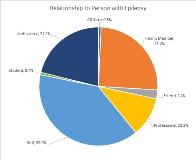A 3-Year Review of Epilepsy Foundation 24/7 HELPLINE: Utilization, Constituent Needs, Resource Referral
Abstract number :
1.405
Submission category :
13. Health Services (Delivery of Care, Access to Care, Health Care Models)
Year :
2018
Submission ID :
502404
Source :
www.aesnet.org
Presentation date :
12/1/2018 6:00:00 PM
Published date :
Nov 5, 2018, 18:00 PM
Authors :
Thomas Buckley, Epilepsy Foundation; Elaine Kiriakopoulos, Epilepsy Foundation; Cathleen Cooney, Epilepsy Foundation; Steven Owens, Epilepsy Foundation; Jody Kakacek, Epilepsy Foundation; Patricia O. Shafer, RN, MN, Epilepsy Foundation; and Joseph I. Sirv
Rationale: Health helplines are integral to present-day healthcare, offering fast, low-cost, and geographically unrestricted access to health information, psychosocial support and links to resources and referrals. This study examines the utilization of the Epilepsy Foundation’s 24/7 Helpline service which offers information, support, resources and referrals for people living with epilepsy, their families, and healthcare professionals. Methods: A three-year retrospective analysis of 35,465 Helpline contacts was completed. Helpline intake data were entered using the iCarol call management system. Results: Data demonstrate a diversity of callers, as defined by their relationship to epilepsy (Figure 1), methods used to access Helpline and initial referral source. The Helpline callers included persons living with epilepsy (39%), family members (25.2%) and medical professionals (10.8%). Data on methods used to access the Helpline reveal that in addition to telephone (65.5%), approximately ? accessed via email (20.3%) and epilepsy.com online submissions (11%). Callers reported learning about the Epilepsy Foundation Helpline via epilepsy.com website (23.0%), local network 3.2%, medical professional (2.8%), friend/family member (2.4%) and social media (2.1%). 50.1% did not disclose how they learned about Helpline; 9.6% had previously accessed the Helpline. Findings highlight multifaceted needs (Figure 2). Requests for supporting medical information (19.8%), general epilepsy information (14.8%) and safety (first aid, devices, seizure dogs) (10.3%), were most frequent. Inquirers’ needs did not vary based on time of day. Frequently, psychosocial and medical needs intertwined with need for information and referral. The Helpline’s ability to meet caller needs was examined by reviewing resource and referral patterns. Approximately 40% of referrals were made to programs provided by the Epilepsy Foundation or local network office, and 57.1% were referred to other community programs/services. During the past 18 months, 99.5% of caller needs were met. Unmet needs were most frequently due to the lack of an available local program (43.5%). Conclusions: This 3-year review of Helpline data reveals a diverse group of stakeholders and a broad spectrum of inquirers’ needs. Utilization remained consistent over 3 years, with telephone access being primary contact method. There is potential for the Epilepsy Foundation 24/7 Helpline to further improve patient access to information about diagnosis and treatment, augment access to specialized epilepsy care, enhance psychosocial support, and continue to build national resource and referral networks. Funding: The Epilepsy Foundation Helpline is made possible with funding from the Centers for Disease Control and Prevention (CDC) under cooperative grant agreement number 1 NU58DP006256-02-00. Its contents are solely the responsibility of the Epilepsy Foundation and do not necessarily represent the views of the CDC.

.tmb-.jpg?Culture=en&sfvrsn=a625606e_0)